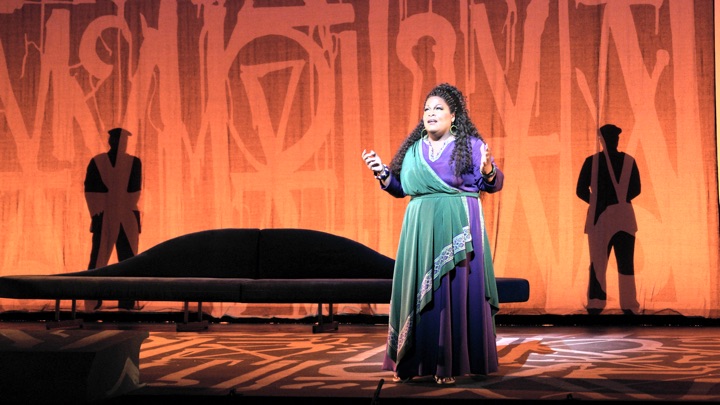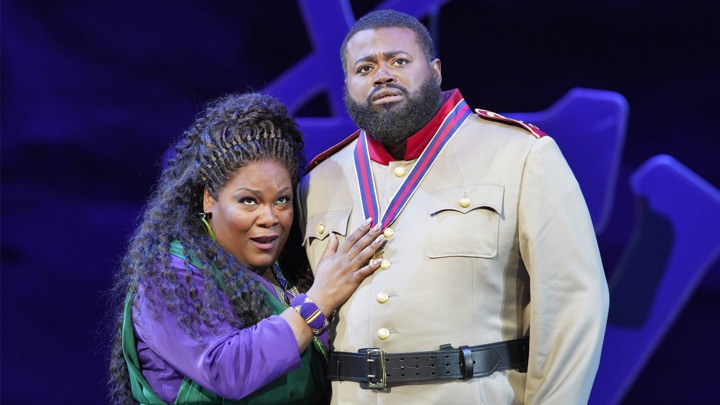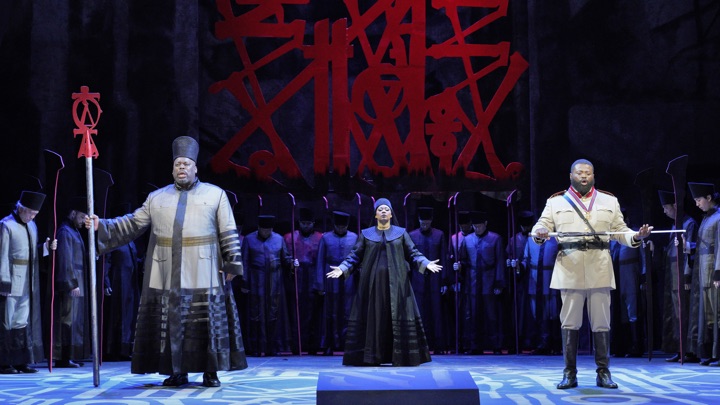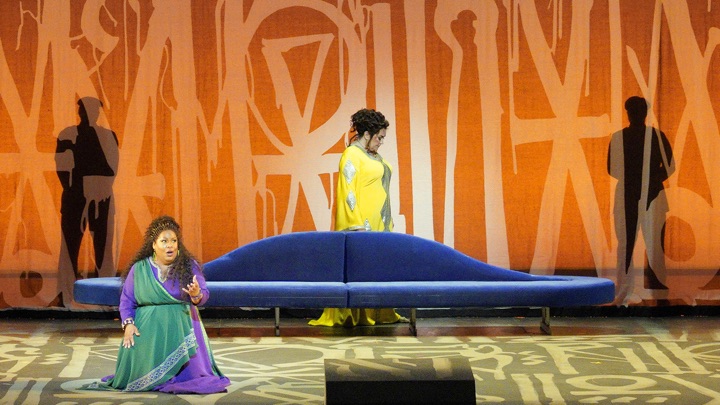

When LA Opera finally got around to mounting Verdi’s elephant parade in 2000 I made sure to be there. He Who Must Not Be Named was still singing tenor roles at that point and hadn’t glommed onto Amonasro as a career extension so he conducted. We had a pair of mighty Wagnerians as the lovers, Deborah Voigt and Johan Botha, both known more for volume than nuance. I had seats in the third row and I remember my ears literally ringing.
Voigt, lacking the piano high “C” the composer requested, simply turned her back to the audience during the climax of “O patria mia” and sang the note upstage to simulate softness. Mr. Botha actually managed a nice mezzo-piano Bb at the conclusion of “Celeste Aida” but sang like a bull for the rest of the evening.
Nina Terientieva and Simon Estes both brought more gravitas than voice to their roles. The production, as old as the pyramids themselves, and borrowed from Houston, was by Pier-Luigi Pizzi and heavily stylized. It did indeed host an enormous Fisher-Price elephant on wheels at the finale of the triumphal scene.
The same sets and costumes went up 5 years later with a soprano who was in a state of expectation as they say. Her 8th month if I recall.
Pre-pandemic plans were afoot to mount a production new to LA in 2021 and to say I wasn’t excited about the announced casting would be an understatement. Then, in the only case I can recall of Covid actually improving something, the rescheduled season was revealed and I couldn’t believe our good fortune with the singers.
Operas with the locale exotique have always been prime targets for great artists to have a go at designing for the stage. Salvador Dail’sSalome for Covent Garden. Cecil Beaton’s Met Turandot and Marc Chagall’s Die Zauberflote. My first Tristan und Isolde and Frau ohne Schatten were both David Hockney creations.
Earlier Dame Zandra Rhodes had taken a bash at both Aida and Bizet’s Pearl FIshers to general acclaim. So when the graffiti-inspired artist RETNA (Marquis Duriel Lewis) was announced as the production designer for this multi-backer in 2016 I was mighty intrigued and thought it a fresh choice.
RETNA’s already hieroglyphic style seemed ready made for this work and an initial poster design was extraordinarily provocative. So with the help of set designer Michael Yeargen and lighting designers Mark McCullough and his associate Peter W. Mitchell we have an Egypt that doesn’t necessarily look like Egypt and obviously takes place closer to our own era than Verdi’s antiquity.
We open in a war room that resembled nothing so much as a parking garage. Amneris’s boudoir was certainly recognizable as such but I’d be hard-pressed to pinpoint the location of the Triumphal Scene other than the inside of a large discothèque (it was acoustically potent I will give it that). The banks of the Nile, in spite of some free-form public park sculptures, are parking-garage adjacent. The final scene in the tomb was atmospheric but lacked the aforementioned tomb.
Costumes by Anita Yavich were fairly standard banana republic uniforms for the men and vaguely Mediterranean modest muumuus for the ladies.
Musically we had a slightly bumpy night. A few moments of disconnect between the pit and stage with the chorus (when they had to move and sing at the same time) smelled like opening night. The horns completely whiffed their entrance in the lead up to “Celeste Aida” which was unfortunate. Later in Act II, during Radames’ “Nel fiero anelito” they just couldn’t articulate Verdi’s musical figures to speed. I’m certain these things will iron themselves out going forward (with some stern looks from the podium).
That said, the string tone from the LA Opera Orchestra was so sumptuous it bordered on the demonic. The prelude shimmered elegantly and there was some robust highlighting on the double bass line during the Judgment scene that upped the dramatic ante considerably. All the ballet music was a delight to the ear as I’m certain were the atmospheric preludes to Act III and IV if only I could have heard them over the general chatter of the audience.
Maestro James Conlon knows Verd, let there be no doubts there. He was a galvanizing force all evening. An attentive and commanding accompanist for his singers he husbanded, with the help of his magnificent cast, both the most exciting Triumphal and Judgment scenes I’ve ever heard live. His dedication is to the composer not to himself and he doesn’t overlay an egocentric “interpretation” onto the performance. We’re listening to Verdi’s Aida, not Conlon’s, and I have no higher praise.
Perhaps the most exciting debutante (save one) was Peixin Chen as the King. An absolutely booming bass voice that was tremendously impressive in the theater. He sang his brief lines with such confidence you immediately wished his role were larger.
Morris Robinson as Ramfis sounds like the Lord God Almighty everytime he opens his mouth. The staging of the Judgment scene allowed him to face the audience for his appeals to Radames and he brought a fervency to the moment that it usually lacks.
George Gagnidze was vocally a mite tentative on his entrance. He does get points for not telegraphing his presence in the crowd because you can usually spot Amonasro from a mile off. He got the whole, “Ma tu, Re…” ensemble off to a perfect start. Later by the Nile he was blunt of voice and intent but was a good foil for our Ethiopian Princess.
Our Amneris was the soprano Melody Moore and if this raises a few eyebrows there is a long history of rich-voiced sopranos taking on what Verdi wrote as a mezzo role. Starting almost from the beginning with Amelie Materna and Josephine Schefsky.
Closer to our own time Marjorie Lawrence, Ghena Dimitrova and Margaret Jane Wray all enjoyed considerable success as the Egyptian Princess. The benefits of this casting were immediately apparent both for the music and the drama. Ms. Moore knows how to project a beautiful imperiousness. The proud shell over the vulnerable core.
As well she manages a sly insincerity that lets the audience in on her character’s truth but never her fellow players. She laid a beautifully subtle trap for Aida in their duet and then her frustration in Act IV with Radames” continued refusal to renounce Aida was palpable.
Vocally because of her naturally higher vocal placement she showed an ease of amplitude in many parts of the role that most interpreters simply can’t. The repeated “Vieni, amor mio” in her chambers at the top of Act II, which are usually ungainly sounding, here were the voluptuous love call Verdi intended.
The beauty of her instrument made her simply a woman wronged and not the usual vicious intriguante. She played an extraordinarily nuanced Judgment that kept building on itself. First bringing applause after her short arioso following the confrontation with Radames and then unleashing an inferno of tireless vocalism at the denunciation of Ramfis. Honestly the first Amneris I’ve seen live who didn’t run out of steam on the final pages. She was richly rewarded for her efforts by the audience. Brava!
We were lucky also in the casting of Russell Thomas as our Radames. It’s a big sing for any tenor and there’s the unavoidable hurdle of a monstrously difficult aria right at the top of the evening. His “Celeste Aida” certainly wasn’t perfunctory but he didn’t linger either.
And although he hit the final Bb fortissimo he did repeat the “Vincino al sol” down the octave giving it the quiet ending the composer desired. Once that was out of the way his vocalism was strong and rich with emotion all evening. Fervent in the Temple scene and unstintingly heroic during the finale to Act II. He also offered loving support to his Aida at the end.
The most important debutante of the evening was our Aida herself Latonia Moore. I’m just going to embarrass myself right off the bat by saying when she sang her opening phrase I had to fight my reflexes not to burst into tears. I think I’ve only had that reaction to a voice two or three times in my whole life. The beauty of her sound was literally overwhelming. So large and cleanly focused, it projected easily over the orchestra and was immediately identifiable in ensemble.
She lavished her voice on her every phrase and it became clear that she and Moore were really the two people onstage who were completely dedicated to communicating the text to the audience. The very effort of singing music this demanding requires so much focus and attention from the singer it often becomes like Italian word salad. The opening trio brought a spontaneous ovation.
Her “Ritorna vincitor” ran a prodigious range of emotion and vocal nuance. Sometimes the tones went a bit rough at the bottom but the effect. She capped the Triumphal scene by holding a titanic high note straight through over into the repeat of “Gloria all’Egitto” (Her party trick. She did it at the Met Lincoln Center 50th Gala and it’s magic).
After giving 150% in the first two acts it became apparent during the Nile scene that Ms. Moore had actually been fighting an indisposition. In “O patria mia” she had trouble with the long and gentle ascension to the piano high C Verdi wanted.
The glory of the tone remained however throughout the evening and I don’t think many civilians (besides we opera connoisseurs) were frankly even aware. Even with its flaws it was a beautiful and very exciting performance. Singing Aida healthy is difficult enough. I’m not going to quibble over a few notes. (Welcome to Los Angeles and our hideous air quality!)
Francesca Zambello was responsible for this staging when it was new and since she was in Washington, D.C. birthing a fledgling Carmen, directing duties were handed over to Katrina Bachus. I’m going to say I’m not a fan of this staging primarily because we never had a clear idea of where we are to begin with.
It seemed to be a totalitarian government from the looks of things but points weren’t sharpened enough and there was hardly any brutality. The opening in the war room worked well but then later during the Triumphal scene the entry of the prisoners almost went for nothing and at the end the pile of wrapped artifacts as engagement presents for Amneris and Radames was just odd.
The staging couldn’t decide if it was realistic or abstract nor could the set. That said the modern setting allowed our tenor and sopranos to interact off of one another like people rather than strike the stereotypical poses and typical semaphore gestures of antiquity that we’re used to. Something that all three took full advantage of. So that was refreshing.
Choreographer Jessica Lang’s first two ballets, in the temple and then the children’s dance in Amneris’ chamber, were charming. The divertissement in the Triumphal Scene lacked a point.
On the whole, though, this is a magnificent production of Aida with a monstrously talented cast that deserves to be heard. Five more performances remain through June 12 and I’m attending that last matinee with friends because when could something like this happen again?
Photos: Cory Weaver




























Comments